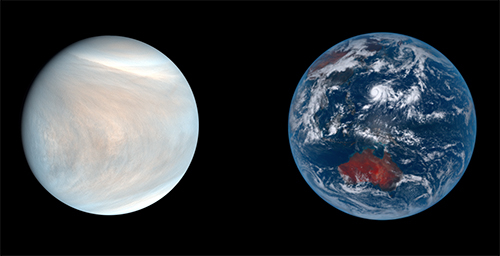
PLANET OGLE-2012-BLG-0950LB. Credit: NASA/GODDARD/F. REDDY
An international research team led by Dr. Daisuke Suzuki (ISAS) has reported a statistical analysis showing that sub-Saturn giant exoplanets are common, not rare. This finding could alter the standing theory of planet formation that predicts an alien world with a mass that's between that of Neptune and Saturn, and its location beyond the "snow line" of its host star, is rare.
The study was published in the December 20th issue of The Astrophysical Journal Letters.
"We were just finishing up the analysis when the mass measurements of OGLE-2012- BLG-0950Lb came in," said Dr. Suzuki. "This exoplanet was first detected by the microlensing method, one of the detection methods of exoplanets, and the mass was estimated with high accuracy based on the observations by the Keck II telescope and the Hubble Space Telescope. This planet confirmed our interpretation of the statistical study."
Dr. Suzuki explains, "only the microlensing method is currently sensitive enough to detect planets with less than Saturn's mass in orbits beyond the snow line, or frost line, of the host stars."
Microlensing leverages a consequence of Einstein's theory of general relativity: the bending and magnification of light near a massive object like a star, producing a natural lens on the sky. In the case of OGLE-2012-BLG-0950Lb, the light from a distant background star was magnified by OGLE-2012-BLG-0950L (the exoplanet's host star) over the course of two months as it passed close to perfect alignment in the sky with the background star.
By carefully analyzing the light during the alignment, an unexpected dimming with a duration of about a day was observed, revealing the presence of OGLE-2012-BLG-0950Lb via its own influence on the lensing.
For the statistical study, the properties of 30 sub-Saturn planets found by microlensing were analyzed and compared them to predictions from standard theory of planetary system formation, i.e., the core accretion theory.
The snow line is the distance in a protoplanetary disk at which it is cold enough for water to condense into ice. At and beyond the snow line there is a dramatic increase in the amount of solid material needed for planet formation. According to the core accretion theory, the solids are thought to build up into planetary cores first through chemical and then gravitational processes.
"A key process of the core accretion theory is called "runaway gas accretion," said Dr. Suzuki. "Giant planets are thought to start their formation process by collecting a core mass of about 10 times the Earth mass in rock and ice. Then, the accretion of gas and dust is expected to speed up exponentially in this runaway gas accretion process. This process stops when the supply is exhausted. If the supply of gas is stopped before runaway accretion stops, we get "failed Jupiter" planets with masses of 10-20 Earth-masses (like Neptune)."
The runaway gas accretion scenario of the core accretion theory predicts that planets with masses of 20 - 30 earth's mass are expected to be rare. Suzuki's team compared the distribution of planet-star mass ratios found by microlensing to distributions predicted by the core accretion theory.
They found that the core accretion theory's runaway gas accretion process predicts about 10 times fewer intermediate-mass giant planets than those seen in the microlensing results. This new result suggests that the runaway growth scenario may need revision.
This discrepancy implies that gas giant formation may involve processes that have been overlooked by existing core accretion models, or that the planet-forming environment varies considerably as a function of host star mass or host star's situation such as stellar density.
"We want to observe a larger number of exoplanetary systems and determine the masses of the alian worlds in high accuracy. In this way, we can study the census of exoplanetary systems in statistically significance. "
Comparison of Saturn and Neptune to an artist's conception of planet OGLE-2012-BLG-0950Lb.
Credit: NASA/JPL/GODDARD/F. REDDY/C. RANC


